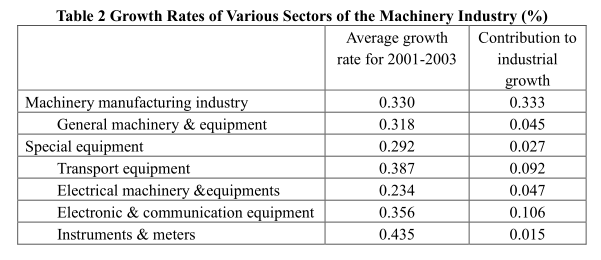An Analysis of the Structure and Trend of the New Round of Economic Growth (Abridged)
2005-02-11
Yang Jianlong,Research Department of Industrial Economy of DRC
Research Report No.200, 2004
II. An Analysis of the Features and Mechanism of the Heavy and Chemical Industries in the New Round of Economic Growth
The rapid growth of the heavy and chemical industries is the most striking phenomenon of the new round of economic growth. Specifically, there are three major fast-growing industry groups:
1. The first major fast-growing industry group: the machinery industry

One category is the sectors that are closely related to the structural upgrading of personal consumption, including electronic and communication products, transport equipment and household appliances. In terms of demand, the rapid growth of this group benefited, first of all, from the growing demand arising from the structural upgrading of personal consumption. Since the late 1990s, the growth of the traditional durable consumer goods for Chinese families has visibly slowed down. But a new generation of durable consumer goods such as computers, modern communication products and automobiles has entered a stage of faster growth. In terms of electronic and communication products and transport equipment, the ratio of personal consumer demand has respectively reached 10 percent and 17 percent and is more than twice the levels in the mid-1990s. Personal automobile possession increased by more than 30 percent in 2003 over the level in 2001, the coverage of fixed telephones and mobile phone went up by nearly 100 percent, and home computer users increased nearly five times. In addition, drastic growth was also posted for air-conditioners, water heaters and color television sets. A rough estimate based on the direct consumption indexes for the 2000 input-output table indicates that demand growth arising from the structural upgrading of personal consumption contributed more than 20 percent to the growth of this industry group. Secondly, the group’s rapid growth also benefited from export growth. For example, the export of electronic and communication products accounted for more than 40 percent of the total output of this industry group. Export growth contributed no less than 40 percent to the growth of the whole group.
The other category is the sectors that are closely related to the upgrading of the equipment of various sectors, such as general machinery and special equipment manufacturing. The growth of this category is closely related to the growth of the related downstream sectors. For example, the rapid chemical industry has driven up the demand for special equipment required by the petrochemical sector, and the acceleration of electricity construction boosted the quantity of transformers and other electric equipment needed. As the demand of the downstream sectors is widely scattered, this category as a whole has still maintained a fast-growing stance even though different sectors have different and changing growth rates. Compared with the first category, this category has been highly influenced by investment growth. For example, nearly 50 percent of the products of the general machinery sector have been used to meet the equipment demand arising from investments in fixed assets, with only 30 percent being used within this sector. Export has had only a moderate impact on this sector.
2. The second major fast-growing industry group: iron and steel (including metallurgy, rolling and metal products), nonferrous metals and related excavation sector
This industry group is made up of the fastest-growing sectors of all, with an average growth rate of more than 24 percent during the 2000-2003 period. In terms of demand, the machinery industry and especially the sectors that make general machinery and special equipment have been the largest users, followed by construction which accounted for about 20 percent of the total output of this group. In addition, export growth also made certain contributions. On the surface, industrial sectors of this category are typically intermediate input industries. But in terms of causes, their growth has also been strongly pushed by the structural upgrading of consumption. In the area of construction, for example, the housing construction for urban and rural residents increased about 1.2 billion square meters each year, driven by the personal demand for housing consumption. This growth rate is twice that in the early 1990s and is faster than in other types of construction. Housing construction has become one of the main driving forces for the rapid growth of the whole construction industry. In terms of the structural of the demand for steel products, the construction industry accounted for more than 50 percent. Based on this, we can estimate that the structure upgrading of personal housing consumption has contributed at least 10 percent to the growth of the final demand of the iron and steel industry. Besides, the continuous growth in the scope and quantity of large steel structures used for the construction of municipal infrastructure facilities will also maintain a rapid growth in the demand for iron and steel products.
3. The third major fast-growing industry group: the chemical industry
The pace of growth of the chemical industry is only slightly slower than the preceding two groups. During the 2001-2003 period, the average growth rate was 24 percent, which was about 3 percentage points higher than the overall industrial growth rate and contributed about 10 percent to the overall industrial growth. Compared with other industries, the chemical industry is noted for diverse sectors and extensive applications. Therefore, its demand growth was also driven from various sectors.
Compared with the machinery industry and the iron and steel industry, the chemical industry’s fast growth has been more relevant to the final demand of personal consumption. Therefore, it also has had the closest links with the structural upgrading of personal consumption. For example, plastic products, chemical products of daily use, and various materials used for housing decoration contributed about 20 percent to the growth of the final demand of chemical products as estimated in the 2000 input-output table.
…
If you need the full text, please leave a message on the website.














